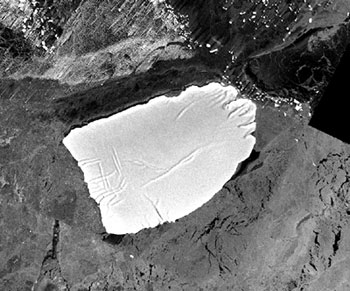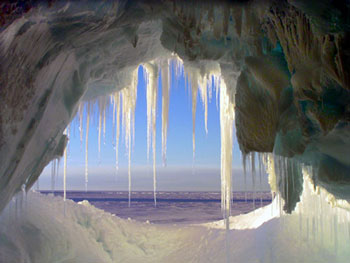Singing iceberg discovered in Antarctica
Rhett A. Butler, mongabay.com
November 25, 2005
Scientists believe they have found a singing iceberg in Antarctica, according to research published in Science on Friday.
Researchers at the German Alfred Wegener Institute for Polar and Marine Research recorded seismic vibrations originating from an iceberg at the Antarctic Neumayer Station. The sound vibrations from the iceberg produced harmonic sounds with up to 30 overtones, but were not audible to the human ear due to their low frequency of around 0.5 hertz. However, by playing the sounds at higher speed, the iceberg sounded like a swarm of bees or an orchestra warming up.
 Probably tremors originated from the extended crevice-systems on the surface and in particular the borders of iceberg B-09. Photo credit: RADARSAT-Aufnahme der Canadian Space Agency, 1997. |
According to a news release by the institute, the scientists suspect that water flowing within the iceberg’s system of crevasses and tunnels, is stimulating elastic vibrations, similar to those of an organ pipe. Initially researchers thought that volcanic activity was the cause of the low frequency vibrations or tremors’, but satellite imagery led them to discover that a giant iceberg covering an area of 30 by 50 kilometers was the source of the acoustic signals.
Results might facilitate volcano research
The data might help vulcanologists get a better understanding of volcanic processes where vibration patterns are similar.
 A complex of tubes and crevices characterizes the internal structure of many icebergs. Photo credit: Alfred-Wegener-Institut. |
“Understanding these recordings that are so comparable to volcanic tremors might in turn also help vulcanologists to explain the causes of volcanic tremors,” said Christian Müller of Fielax GmbH, a private firm involved in the research, in a statement. “In contrast to complex volcanic systems, icebergs have a simpler structure.”
The article “Singing icebergs” was published November 25 in “Science” (Vol. 310, issue 5752).
This article used information from a Alfred Wegener Institute news release.